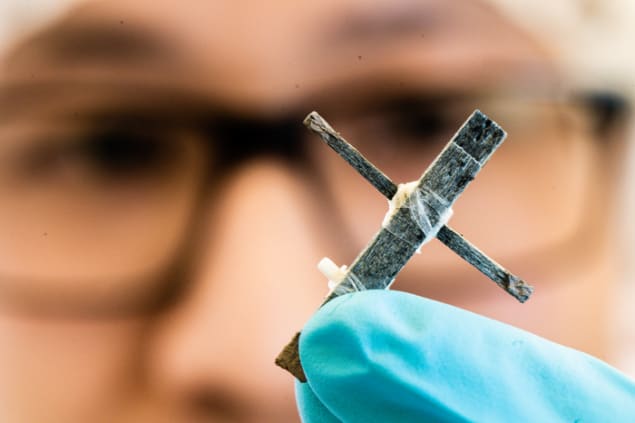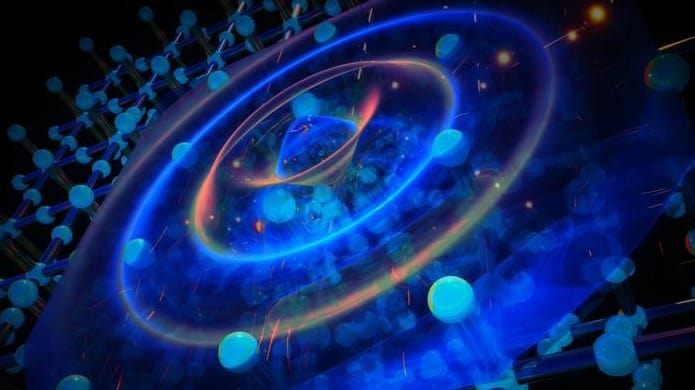
There are many physicists working on materials and every year we look forward to writing about some of the most exciting research in this field. This year was no exception and here are some of our favourite materials stories from 2023.
A transistor made from wood
In an era when new materials are devised using artificial intelligence, I find it comforting that we are also in the midst of a resurgence of interest in wood. It is surely one of the most ancient of materials used by humans and today researchers around the world are developing new ways to use this renewable resource to create exciting materials. Now, Isak Engquist of Linköping University’s Laboratory for Organic Electronics and colleagues in Sweden have built a transistor out of a plank of wood. They did this by incorporating electrically conducting polymers throughout the material in a way that creates space for an ionically conductive electrolyte. Their new fabrication technique makes it possible to use wood as a template for numerous electronic components, but the team admits that wooden transistors would come no-where near the performance of conventional devices. One possible application could be the integration of electronics into living plants – but even if there are few practical uses for a wooden transistor, it is still a neat trick.
Cubic ice observed in pure form for the first time
Like wood, water is a ubiquitous material with extraordinary properties. Unlike most substances, solid water is less dense than liquid water, making aquatic life possible across vast swathes of the Earth where temperatures regularly fall below 0 °C. Ice is known to come in at least 20 different crystal structures. Now, researchers in China led by Lifen Wang and Xuedong Bai of the Beijing National Laboratory for Condensed Matter Physics and the Songshan Lake Materials Laboratory in Dongguan are the first to confirm the existence of cubic ice, which has a diamond–cubic structure of water molecules. This ice is believed to be responsible for Scheiner’s halo, which is an extremely rare optical effect that creates a ring of light around the Sun at about 28°. This is unlike the usual 22° halo caused by refraction through hexagonal ice crystals. The team created cubic ice on a freeze plate made from monolayer graphene and monitored its formation using cryogenic transmission electron microscopy. Their technique could prove useful for studying how ice of all kinds forms on surfaces.
Superconductor spin-correlation measurement is claimed as a first

One of the triumphs of 20th-century physics is the BCS theory of superconductivity, which was developed in the 1950s to explain why some materials have zero electrical resistance at very low temperatures. The idea is that electrons in these superconductors pair-up to create bosons. These “Cooper pairs” can then condense to form a superfluid-like substance that can flow without resistance. While there is indirect evidence for the existence of Cooper pairs, physicists had yet to measure a negative correlation between the spins of electrons in a pair – which would be direct evidence for a pair’s existence. Now, physicists in Switzerland and Italy led by Arunav Bordoloi at the University of Basel have used two quantum dots to extract Cooper pairs from a tiny piece of superconductor. They then split the pairs and measured their spin polarizations, finding that they usually pointed in opposite directions – just as predicted by BCS theory.
New type of fractal emerges in spin ices
Decades ago when I was at university, fractals were all the rage – in part because of the high quality visualizations created by Benoit Mandelbrot. So, I am always interested when they pop up in research today. In February, Claudio Castelnovo at the University of Cambridge and colleagues in the UK, Germany, the US and Argentina showed that a new type of fractal is lurking in a spin ice. Spin ices are materials with magnetic moments that are frustrated because they cannot settle into a periodic configuration at low temperatures. Instead, the moments become frozen with a degree of disorder similar to that found in water ice. In 2009, physicists argued that excitations in some spin ices behave like magnetic monopoles. Now, Castelnovo and colleagues have shown that these monopoles move in a fractal world of ever branching trajectories, rather than being free to move in 3D. Studying monopoles in spin ices could be important for a host of applications, says team member Jonathan Nilsson Hallén who is based in Cambridge and Dresden. “Spin ices are one of the most accessible instances of topological magnets, and magnetic monopoles in spin ices are one of the best understood examples of fractionalized excitations,” he says.
Polar bear fur inspires solar-thermal textiles
The white fur of the polar bear provides camouflage in the snowy Arctic landscape. However, you might think that a white coat would do a bad job of warming bears in the sunshine. This is not the case because polar bear fur is designed to channel sunlight to the bear’s dark skin, where it is absorbed efficiently. What is more, the fur is very good at trapping heat radiated by the bear’s skin – essentially creating a greenhouse effect. Now, Trisha Andrew and colleagues at University of Massachusetts Amherst have created a new double-layered fabric inspired by polar bears that absorbs energy from the Sun and indoor lighting and traps it to maintain warmth. When exposed to a light intensity of 130 W/m2 (a dull midwinter day in England) it keeps its wearer just as warm as cotton fabric would – but at temperatures that are 10 °C colder and while weighing 30% less. “Our polar bear fabric could be very useful for managing space heating, which consumes huge amounts of energy, in a more energy-efficient manner, by heating people indoors using ambient lighting instead of room heating,” says Andrew.
Demon quasiparticle is detected 67 years after it was first proposed

We do love a quasiparticle here at Physics World, so we were delighted that in 2023 physicists detected the “Pines’ demon” at long last. First predicted in 1952 by David Pines and David Bohm, this quasiparticle is a quantized electron-density fluctuation in a plasma. The quasiparticle forms when electrons in different bands of a metal move out of phase with one another such that they keep the overall charge static. In effect, a demon is the collective motion of neutral quasiparticles – and a demon is also massless and unable to interact with light. All of this makes the quasiparticles very difficult to detect. Now, Peter Abbamonte of the University of Illinois Urbana-Champaign (UIUC) in the US, and colleagues have found evidence for the demon using a technique called electron energy loss spectroscopy to identify an excitation associated with Pines’ demon in single crystals of strontium ruthenate.
Cement-based supercapacitor makes a novel energy storage system
Humans seem to have a love–hate relationship with concrete. The material’s practicality underpins much of the built environment, yet we decry its sometimes brutal appearance and the vast amounts of carbon dioxide emitted during its production. Now, a team in the US led by MIT’s Franz-Josef Ulm, Admir Masic and Yang-Shao Horn have developed a type of concrete that can be used to create supercapacitors for storing energy. Production begins with a dry mixture of carbon black and cement, to which water and superplasticizers are added. As the material solidifies it creates a fractal-like network of pores that makes the material a conductor with a very large surface area. This is exactly what you want for the electrodes of a capacitor, where the greater the surface area, the greater the capacitance. According to the team, a concrete capacitor the size of a 3.55 m cube would be able to store about 10 kWh of energy. A house built with foundations that contain these capacitors could therefore store a day’s worth of energy – produced by solar panels, for example – and release it when needed. The material could also be used in the base of a wind turbine, where it could store surplus energy until it is needed. The technology could also be used to store renewable energy in infrastructure such as roads and car parks, where the energy could be transferred by induction to vehicles.
Physics World‘s coverage of the Breakthrough of the Year is supported by Reports on Progress in Physics, which offers unparalleled visibility for your ground-breaking research.




